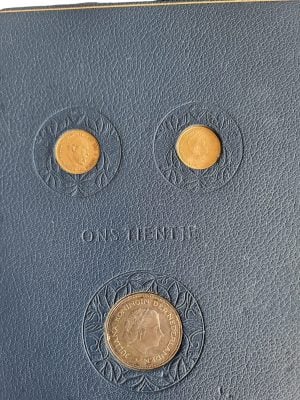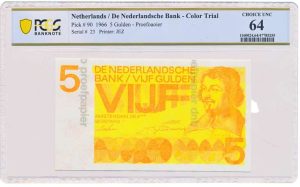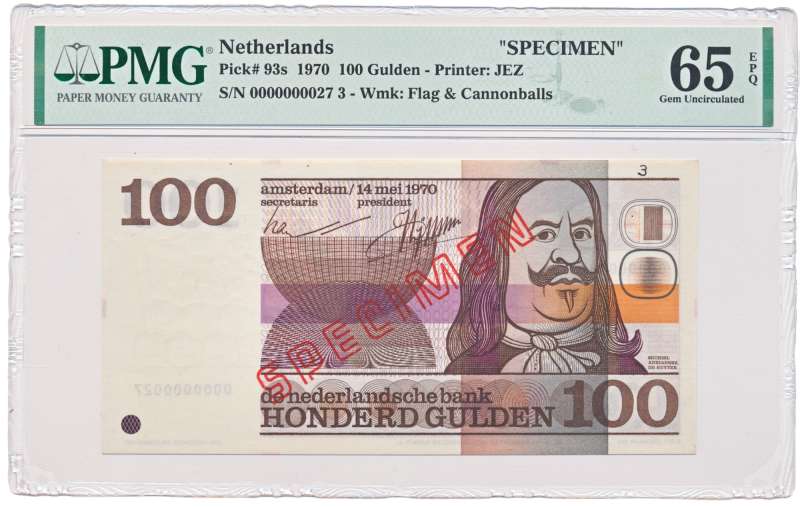Netherlands 100 Guilder 1970 Michiel de Ruyter Specimen PMG65 EPQ
NVMH:122-1
€ 1.095,00 Original price was: € 1.095,00.€ 995,00Current price is: € 995,00.
1 in stock
Aanvullende informatie
| Weight | 5,1 kg |
|---|---|
| Country | |
| Banknote value | |
| Type | |
| Delcampe id |
Beschrijving
Nederland 100 Gulden 1970 Michiel de Ruyter PMG65 EPQ
Hoge kwaliteit
NVMH:122-1
Plomp:PL103
Pick:93S
Kwaliteit: PMG65 EPQ UNC
About the bill:
Hundred guilder 1970 Michiel de Ruyter
The hundred guilder of Michiel de Ruyter is one of the first bills of R. D. E. Oxenaar's legacy series, which came into circulation in the early 1970s. On the front we see the famous Dutch seafarer Michiel de Ruyter, who largely destroyed the English fleet in 1667 with the voyage nat Chatham. On the reverse side of the bill we see a pattern very similar to the rudder of a seventeenth-century battleship. Also in the watermark we see the history of de Ruyter, a Dutch flag in the wind on a pile of cannonballs. The hundred with de Ruyter is one of the bills of Oxenaar's legacy series. Besides de Ruyter, there were also:
– 5 guilder 1966 Vondel;
– 5 guilder 1973 Vondel;
– 10 guilder 1968 Frans Hals;
– 25 guilders 1971 Sweelinck;
– 1000 guilders 1972 Spinoza.
The hundred guilder bill was finally withdrawn from circulation in 1985. The 100 Guilder Snipe then took over.
Specimen banknotes Netherlands
Specimen banknotes are real banknotes that have been invalidated in the printing process. There are often several reasons for this. Specimen banknotes were often sent as sample bills to various banks so that staff could see what the new bills looked like and what the security features were. Also, specimen bills were often used as a test bill so that the client could inform the printing company about the quality of the bill and whether the bill could then actually be printed in larger numbers.
Because the numbers of specimen notes associated with a design are often much smaller than the regular bills of the design, the different types of specimen bills are not included in every catalog. Except in the Plomp catalog, which describes virtually every specimen bill of the Netherlands. Because specimen bills were not intended for circulation, they were eventually sent back to the printer or destroyed, and only a small portion remains today.
Het biljet is eveneens gekeurd door PMG-notes, een bedrijf dat bankbiljetten op echtheid controleert en de kwaliteit vaststelt. Omdat specimen biljetten nog wel eens vervalst worden door het woord specimen over het biljet te drukken, dient dit certificaat dus ook als bewijs van echtheid. Ook het lage serienummer is een indicatie van de echtheid, omdat specimen biljetten vaak een afwijkend serienummer krijgen omdat ze niet zoals de andere biljetten voor circulatie bedoeld zijn.
Dit is dan ook het enige 100 gulden 1970 specimen biljet dat in deze kwaliteit gekeurd is.
Dit biljet is gekeurd in
PMG 65 EPQ, het is dus onbeschadigd en het papier is in goede staat bewaard gebleven.
Now available once for the collector.
See scans for more details.
For questions feel free to send us a message.
Aanvullende informatie
| Weight | 5,1 kg |
|---|---|
| Country | |
| Banknote value | |
| Type | |
| Delcampe id |
You might also like this...
-
Sale!

Our tithe booklet including 2 gold tithes and 2 specimen issues
€ 3.495,00Original price was: € 3.495,00.€ 3.295,00Current price is: € 3.295,00. In winkelwagen -

Netherlands 1 Guilder 1949 Juliana Specimen PMG65
€ 495,00 In winkelwagen -

Netherlands 5 Guilders 1966 Color proof PCGS64
€ 995,00 In winkelwagen



